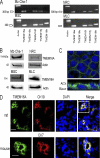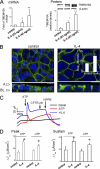Identification and functional characterization of TMEM16A, a Ca2+-activated Cl- channel activated by extracellular nucleotides, in biliary epithelium
- PMID: 21041307
- PMCID: PMC3013035
- DOI: 10.1074/jbc.M110.164970
Identification and functional characterization of TMEM16A, a Ca2+-activated Cl- channel activated by extracellular nucleotides, in biliary epithelium
Abstract
Cl(-) channels in the apical membrane of biliary epithelial cells (BECs) provide the driving force for ductular bile formation. Although a cystic fibrosis transmembrane conductance regulator has been identified in BECs and contributes to secretion via secretin binding basolateral receptors and increasing [cAMP](i), an alternate Cl(-) secretory pathway has been identified that is activated via nucleotides (ATP, UTP) binding apical P2 receptors and increasing [Ca(2+)](i). The molecular identity of this Ca(2+)-activated Cl(-) channel is unknown. The present studies in human, mouse, and rat BECs provide evidence that TMEM16A is the operative channel and contributes to Ca(2+)-activated Cl(-) secretion in response to extracellular nucleotides. Furthermore, Cl(-) currents measured from BECs isolated from distinct areas of intrahepatic bile ducts revealed important functional differences. Large BECs, but not small BECs, exhibit cAMP-stimulated Cl(-) currents. However, both large and small BECs express TMEM16A and exhibit Ca(2+)-activated Cl(-) efflux in response to extracellular nucleotides. Incubation of polarized BEC monolayers with IL-4 increased TMEM16A protein expression, membrane localization, and transepithelial secretion (I(sc)). These studies represent the first molecular identification of an alternate, noncystic fibrosis transmembrane conductance regulator, Cl(-) channel in BECs and suggest that TMEM16A may be a potential target to modulate bile formation in the treatment of cholestatic liver disorders.
Figures







Similar articles
-
Signaling through the interleukin-4 and interleukin-13 receptor complexes regulates cholangiocyte TMEM16A expression and biliary secretion.Am J Physiol Gastrointest Liver Physiol. 2020 Apr 1;318(4):G763-G771. doi: 10.1152/ajpgi.00219.2019. Epub 2020 Feb 24. Am J Physiol Gastrointest Liver Physiol. 2020. PMID: 32090602 Free PMC article.
-
Mechanosensitive Cl- secretion in biliary epithelium mediated through TMEM16A.Am J Physiol Gastrointest Liver Physiol. 2013 Jan 1;304(1):G87-98. doi: 10.1152/ajpgi.00154.2012. Epub 2012 Oct 25. Am J Physiol Gastrointest Liver Physiol. 2013. PMID: 23104560 Free PMC article.
-
PKCα regulates TMEM16A-mediated Cl⁻ secretion in human biliary cells.Am J Physiol Gastrointest Liver Physiol. 2016 Jan 1;310(1):G34-42. doi: 10.1152/ajpgi.00146.2015. Epub 2015 Nov 5. Am J Physiol Gastrointest Liver Physiol. 2016. PMID: 26542395 Free PMC article.
-
Bestrophin and TMEM16-Ca(2+) activated Cl(-) channels with different functions.Cell Calcium. 2009 Oct;46(4):233-41. doi: 10.1016/j.ceca.2009.09.003. Epub 2009 Sep 26. Cell Calcium. 2009. PMID: 19783045 Review.
-
Calcium-Activated Cl- Channel: Insights on the Molecular Identity in Epithelial Tissues.Int J Mol Sci. 2018 May 10;19(5):1432. doi: 10.3390/ijms19051432. Int J Mol Sci. 2018. PMID: 29748496 Free PMC article. Review.
Cited by
-
Mechanosensor transient receptor potential vanilloid member 4 (TRPV4) regulates mouse cholangiocyte secretion and bile formation.Am J Physiol Gastrointest Liver Physiol. 2020 Feb 1;318(2):G277-G287. doi: 10.1152/ajpgi.00176.2019. Epub 2019 Nov 25. Am J Physiol Gastrointest Liver Physiol. 2020. PMID: 31760763 Free PMC article.
-
New insights into the pathogenesis of primary biliary cholangitis asymptomatic stage.World J Gastroenterol. 2023 Oct 7;29(37):5292-5304. doi: 10.3748/wjg.v29.i37.5292. World J Gastroenterol. 2023. PMID: 37899787 Free PMC article. Review.
-
Signaling through the interleukin-4 and interleukin-13 receptor complexes regulates cholangiocyte TMEM16A expression and biliary secretion.Am J Physiol Gastrointest Liver Physiol. 2020 Apr 1;318(4):G763-G771. doi: 10.1152/ajpgi.00219.2019. Epub 2020 Feb 24. Am J Physiol Gastrointest Liver Physiol. 2020. PMID: 32090602 Free PMC article.
-
TMEM16A Ca2+-activated Cl- channel inhibition ameliorates acute pancreatitis via the IP3R/Ca2+/NFκB/IL-6 signaling pathway.J Adv Res. 2020 Jan 21;23:25-35. doi: 10.1016/j.jare.2020.01.006. eCollection 2020 May. J Adv Res. 2020. PMID: 32071789 Free PMC article.
-
Characterization of Cardiac Anoctamin1 Ca²⁺-Activated Chloride Channels and Functional Role in Ischemia-Induced Arrhythmias.J Cell Physiol. 2015 Feb;230(2):337-46. doi: 10.1002/jcp.24709. J Cell Physiol. 2015. PMID: 24962810 Free PMC article.
References
Publication types
MeSH terms
Substances
Grants and funding
LinkOut - more resources
Full Text Sources
Other Literature Sources
Miscellaneous

